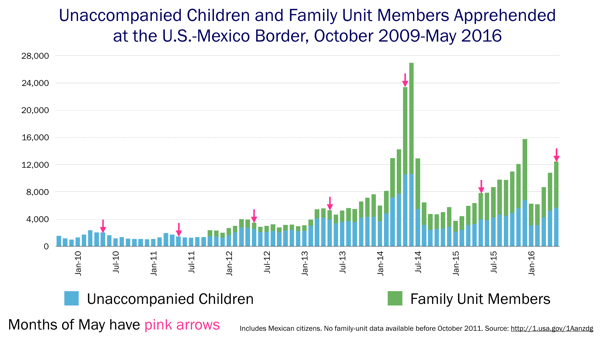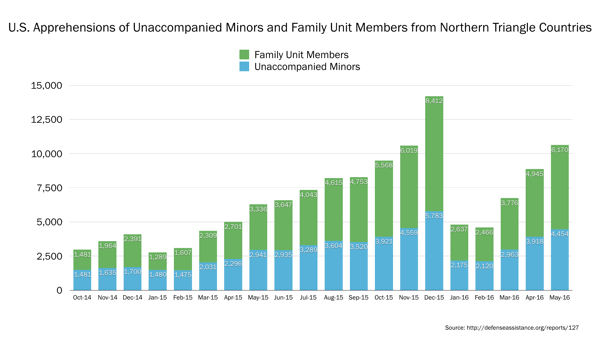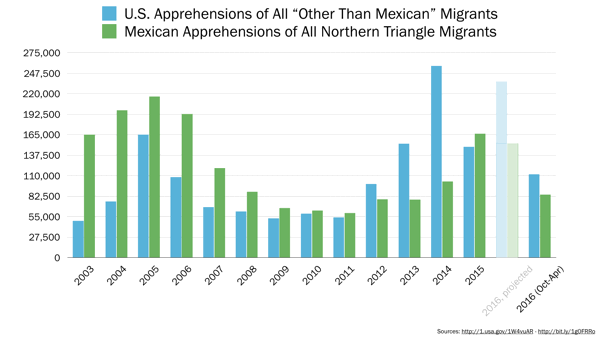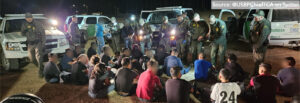A Situation Demanding Creative Solutions, Not a Crisis Demanding Another Crackdown
Two years ago this month, Americans were shocked by images of tens of thousands of Central American families, and children traveling alone, crossing from Mexico and jamming Border Patrol holding facilities in south Texas. Many responded compassionately, noting that much of the migrants were fleeing out-of-control violence and needed protection. Others, among them politicians eyeing the 2014 midterm elections, laid blame on the Obama administration’s policies, portraying the Central American exodus as a sign of an insecure border.
The mid-2014 crisis ended abruptly, as a Mexican crackdown on Central American migrants reduced their numbers for a while. Since then, though, the U.S. government has made few adjustments to its immigration or asylum policies, other than improving reception procedures for unaccompanied children and limiting family detention. And it has only begun to roll out programs that aim to address the reasons why so many citizens of El Salvador, Guatemala, and Honduras are fleeing.
The numbers are rising again. In May 2016 Border Patrol apprehended 4,454 unaccompanied Central American children and 6,170 members of Central American family units. This was the second-largest monthly total since the 2014 crisis subsided, in August of that year. In all of fiscal 2014 (October 2013-September 2014), Border Patrol apprehended a record 113,039 children and family unit members from El Salvador, Guatemala, and Honduras (about one in every 270 citizens of those countries). With 4 months to go, the total for fiscal 2016 is already 69,886—which exceeds all of fiscal 2015 and may come close to the 2014 record.
This does not mean that a new crisis is upon us. Instead, what we are experiencing now is, to use a tired phrase, “the new normal.”
The number of children and family members encountered at the border in May 2016 was large, but it was about half the number apprehended in May 2014. (Due to seasonal conditions, May is usually one of the heaviest months of the year.) May’s arrivals did not overwhelm U.S. authorities’ capacities: there was no footage of children crowding the loading dock at the McAllen, Texas Border Patrol station, because all were processed and handed over to the Department of Health and Human Services in an orderly manner.
Nor is the current increase a sudden or dramatic “wave.” What we have seen for nearly a year and a half is a steady tide: successive months of gradual increases in migration, with only one interruption.
After July 2014, new arrivals of Central Americans plummeted. Much credit went to a U.S.-backed crackdown by Mexican immigration and police authorities in the country’s south, near the border with Guatemala. Mexico’s “Southern Border Program” curtailed travel atop cargo trains, and appeared to disrupt migrant smugglers’ operations for months. Mexico’s apprehensions of migrants from Central America (the green bars in the chart below) doubled from 2013 levels, to heights not seen since the mid-2000s.
(During the mid-2000s, Mexico apprehended more Central Americans than it does now. This drew little notice at the time, however, because very few of the detained Central Americans were minors or families, and because in those years of higher migration from Mexico, the Central American migrant population made up a much smaller proportion of those detained in the United States.)
Mexico’s crackdown drew criticism from WOLA and other human rights advocates because of documented abuses, and because of a failure to address the protection concerns of children and families who could qualify for asylum or refugee status.
Meanwhile, the Southern Border Program’s impact proved ephemeral. U.S. apprehensions of children and family members from El Salvador, Guatemala, and Honduras began to increase again in early 2015. Steady monthly growth continued virtually unbroken throughout the year, defying an expectation of decreased migration in autumn and winter. After December 2015 ended up being the third-highest month on record, and for reasons we haven’t clarified, child and family migration dipped sharply in January and February 2016, only to resume steady increases in March through May—though at levels below that late 2015 “mini-surge.”
Some press coverage has insinuated that this growth owes to a slackening of Mexico’s crackdown on Central American migrants in its territory. The numbers do not support this. Mexico’s apprehensions of Central American migrants dropped by 8 percent between October 2014-April 2015 and October 2015-April 2016. While this is a slight decrease, the 84,748 El Salvadorans, Guatemalans, and Hondurans detained so far this fiscal year are by far the second most that Mexico has captured in the past nine years’ October-April periods.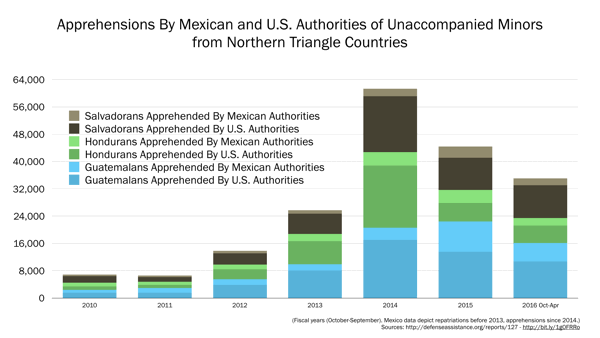
There are other reasons for the increase. For one, Mexican migration authorities working near the Central America border are dealing with a sharp increase in migrants from Cuba who, thanks to the 1966 Cuban Adjustment Act, will be welcomed by U.S. authorities if they can make it to a U.S.-Mexico border crossing. “So far in fiscal year 2016, encounters with Cuban migrants at land ports of entry [U.S.-Mexico border crossings] have increased 84.3% over the same period in fiscal year 2015,” Assistant Homeland Security Secretary Alan Bersin testified in March. If that 84.3 percent rate holds, by the end of fiscal 2016 nearly 80,000 Cubans—1 in every 140 people living on the island—will have crossed through Mexico and arrived at the border in a 12-month period.
Another reason is the adaptability of migrant smugglers operating in southern Mexico. By seeking new routes, or by corrupting Mexican migration and law-enforcement personnel along the way, smuggling networks have adjusted to the surge of enforcement measures within the “Southern Border Program.” Experts and advocates interviewed by WOLA say that this adjustment has come at a cost: migrant smugglers’ fees have increased, with reports of $10,000 for passage from Central America to U.S. territory becoming more common. The increase is probably the result of steeper bribes and greater travel costs along more complex routes. While solid evidence for this is lacking, anecdotal reports and the gradual nature of increased migrant apprehensions point to smugglers’ steady adaptation inside Mexico.
A third, and most fundamental, reason is that the factors driving so many Central Americans to leave their countries—often urgently—remain firmly in place and unchanged. While chronic poverty drives a steady number of Central American citizens to leave, a large proportion are fleeing the world’s highest peacetime indices of violent crime. Though the past few months have seen a decline, El Salvador in 2015 suffered a homicide rate in excess of 100 per 100,000 inhabitants, far higher than any other nation not at war.
Working with honest officials and civil societies throughout the region, we must address these intractable challenges. There is no short-term fix: the post-2014 experience shows that crackdowns alone will not make the problem of Central American child and family migration go away. In upcoming posts, we will take a look at what the U.S. government has tried to do—or must try to do—in Central America, Mexico, and at the border, how the governments in the region should respond to the situation, and suggest better approaches to this “new normal.”

